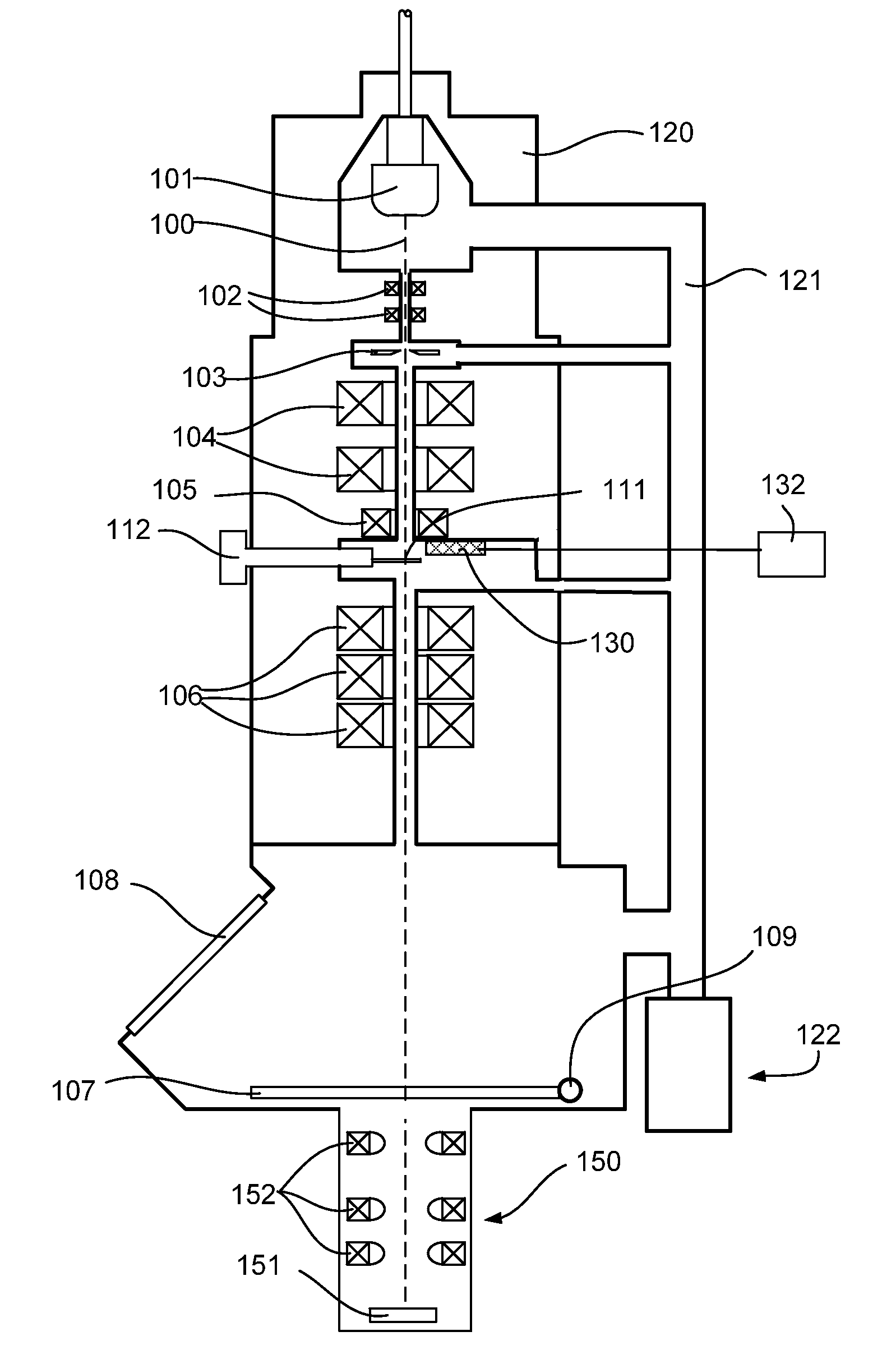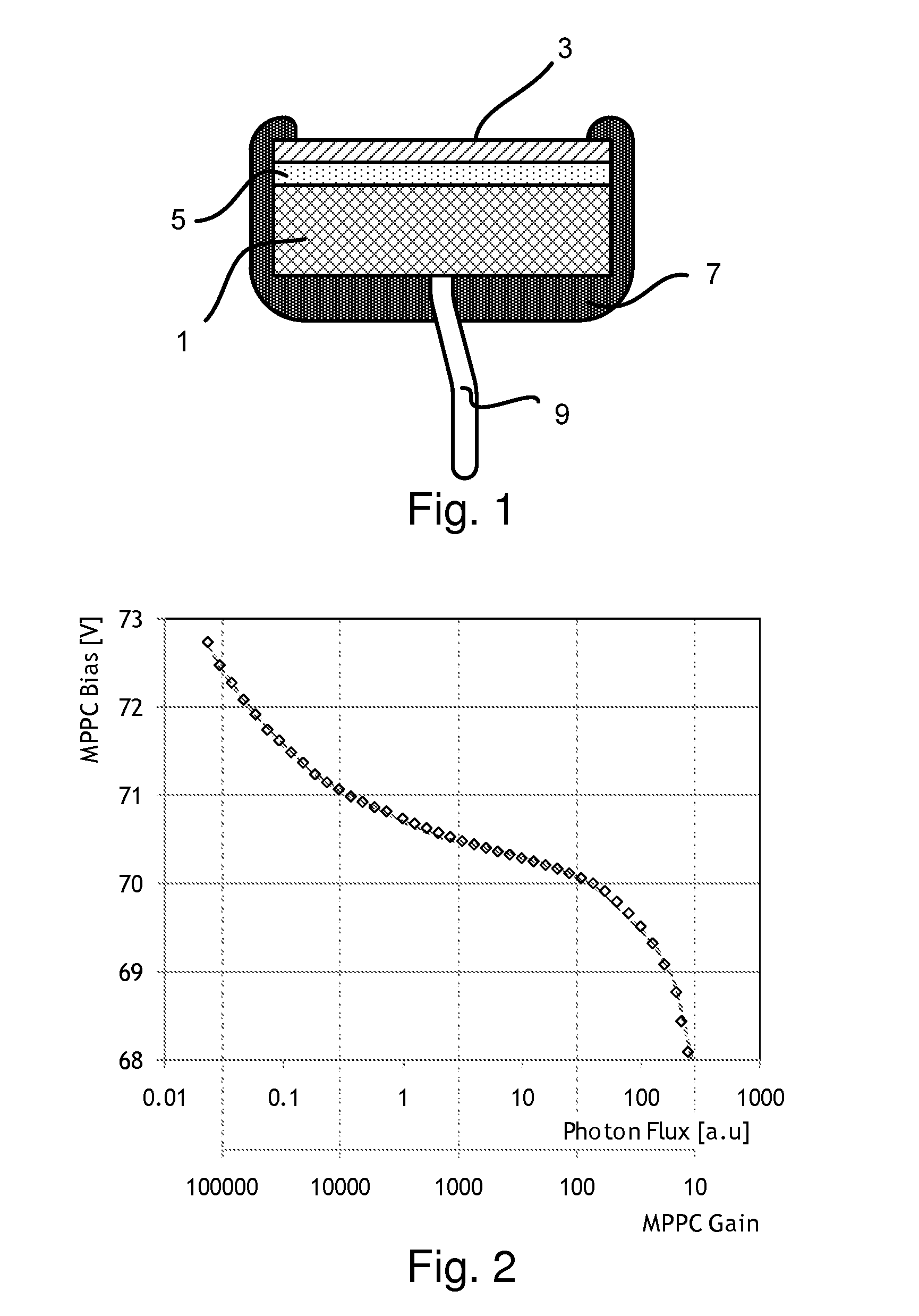Detector for Use in Charged-Particle Microscopy
a technology of charged particles and detectors, applied in material analysis using wave/particle radiation, instruments, nuclear engineering, etc., can solve the problems of affecting the degree of signal loss, and the necessity of large volume of the pmt tub
- Summary
- Abstract
- Description
- Claims
- Application Information
AI Technical Summary
Problems solved by technology
Method used
Image
Examples
embodiment 1
[0033]Multi-Pixel Photon Counters are commercially available from firms such as Hamamatsu Photonics KK, Japan (for example). A Multi-Pixel Photon Counter typically comprises a 2-dimensional array of several hundred or several thousand individual Geiger-APDs, integrated on a small chip. Such a chip typically has lateral dimensions of the order of about 3×3 mm2. In some cases, such chips can be housed in a (metal, ceramic or plastic) canister provided with electrical connection leads; however, such a canister is not necessary, and “naked” Multi-Pixel Photon Counter chips are also commercially available.
[0034]To appreciate the scale of such Multi-Pixel Photon Counter chips, the following comparison is merited. As a reference, an evacuated PMT (photomultiplier tube) with a (typical) diameter of the order of about 2½ cm and a (typical) length of the order of about 10 cm will have a volume of the order of about 80 cm3. In contrast, a canister as referred to above will typically have a vol...
embodiment 2
[0046]FIG. 1 shows a cross-sectional view of a particular embodiment of a composite Multi-Pixel Photon Counter-based detector that, in accordance with the present invention, can be used in a charged-particle microscope. The figure shows a (naked) Multi-Pixel Photon Counter chip 1 that is separated from a scintillator 3 via an interposed layer 5 of optically transparent material, such as glass or a suitable type of grease, for instance. The scintillator 3 may comprise a YAG (Yttrium Aluminium Garnet) crystal, for example.
[0047]The interposed (light guide) layer 5 serves to (partially) match the refractive indices of the scintillator 3 and Multi-Pixel Photon Counter 1, and also to electrically isolate them from one another. In use, the Multi-Pixel Photon Counter 1 will be operated at a relatively low voltage, whereas the scintillator 3 will often be maintained at a relatively high electrical potential (typically of the order of kV). To prevent arc-over, the sandwiched assembly 3, 5, 1...
embodiment 3
[0049]FIG. 2 shows a graph of gain versus bias for a particular embodiment of an Multi-Pixel Photon Counter, obtained using the insights underlying the current invention and exploitable according to the invention in a detector for application in a charged-particle microscope. In this specific case, the Multi-Pixel Photon Counter is a type / model S10931-25P, obtainable from Hamamatsu Photonics KK, Japan, and containing a 2-dimensional array of 14400 Geiger-APDs in a 3×3 mm2 die (chip) area. For this particular Multi-Pixel Photon Counter, the manufacturer specified an operating voltage of approximately 74V; however, for other Multi-Pixel Photon Counters, manufacturers can specify different operating voltages (depending inter alia on the details of the integrated circuit design in the MPPC in question).
[0050]In a test associated with the present invention, the Multi-Pixel Photon Counter in question was subjected to an out-of-spec operating voltage. The graph in FIG. 2 shows the surprisi...
PUM
 Login to View More
Login to View More Abstract
Description
Claims
Application Information
 Login to View More
Login to View More - R&D
- Intellectual Property
- Life Sciences
- Materials
- Tech Scout
- Unparalleled Data Quality
- Higher Quality Content
- 60% Fewer Hallucinations
Browse by: Latest US Patents, China's latest patents, Technical Efficacy Thesaurus, Application Domain, Technology Topic, Popular Technical Reports.
© 2025 PatSnap. All rights reserved.Legal|Privacy policy|Modern Slavery Act Transparency Statement|Sitemap|About US| Contact US: help@patsnap.com



